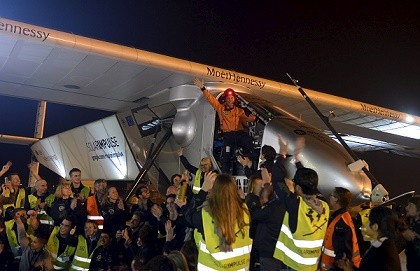Solar Impulse, the world’s first solar-powered aircraft, will attempt to fly for five days from eastern China to Hawaii over an expanse of 8,160 kilometers of ocean, the Sydney Morning Herald reported.
The report said that Andre Borschberg, the plane's pilot, will fly the plane and if he encounters bad weather and other problems, he has only a life raft with him.
Borschberg's Swiss colleague, Bertrand Piccard, who flew the single-seat plane to China in April, is scheduled to fly the plane from Hawaii to Phoenix later this month, the report added.
The two Swiss pilots landed at Chongqing Jiangbei International Airport in south-western China to prepare for the flight and held a press conference.
"Yes, we are nervous. I am nervous also," Piccard said in an interview in Nanjing. "But more than anything, we are impressed. We're in awe of the enormous distance over water that we have to do: Andre for the first part, and me for the second part."
The report said that the two pilots expect to become the first ones to fly a solar-powered plane around the world.
The two pilots said that it took 12 years of planning, fundraising and networking before they launched their expedition in March, flying initially from the United Arab Emirates to Oman, and then to India, Myanmar, Chongqing, China and Nanjing.
Some Chinese students visited the hangar in Nanjing to meet the pilots and take a look at the solar aircraft with its enormous wings.
The solar plane weighs only 2,300 kilograms with four batteries and four propellers. The batteries are recharged by 17,248 feather-light solar cells on top of the wings during flight. The batteries power the aircraft at night, the report added.
According to the pilots, they have to take the aircraft at great height during the late daylight hours, and at night, the plane's engines are turned off, allowing the aircraft to sail for about three hours. The engines are turned back on later, using the power of the batteries until daybreak.



























